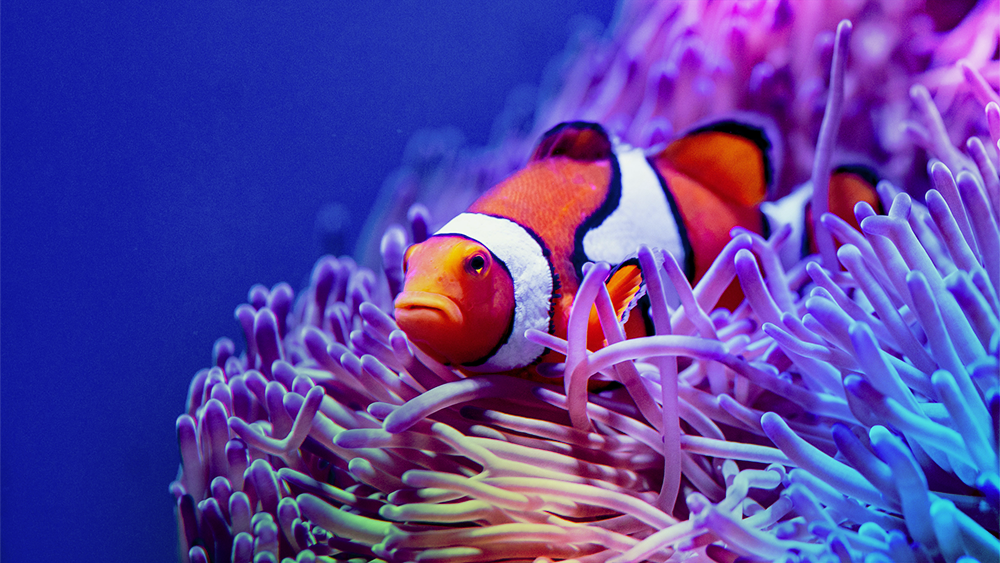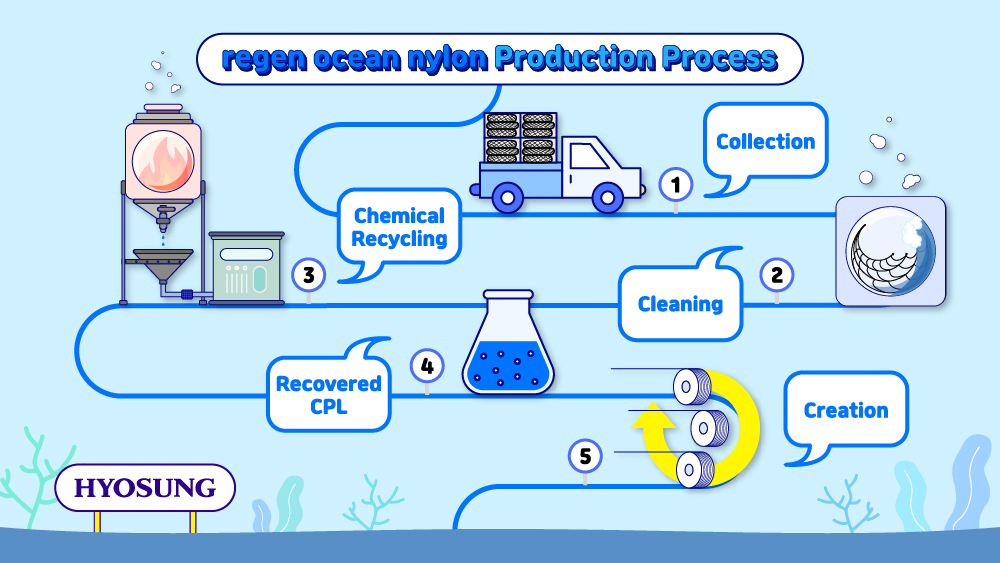Brand Journalism
Brand Journalism
2023-02-08
Waste Fishing Nets, the Troublemaker of the Ocean, Turns into Raw Materials

Deep under the ocean, there lives the adorable Nemo, in colorful coral reefs. Unfortunately, however, we may never be able to see Nemo again, forever. Nemo, a clownfish, was listed as one of the ten species at high risk of extinction by the International Union for Conservation of Nature in 2009. This is because coral reefs, the habitat of clownfish, are being destroyed.
Waste fishing nets are the main culprit of coral reef destruction. Last June, 800kg of abandoned fishing nets covering the coral reefs were removed in the Gulf of Thailand. The coral reefs were bleached and broken by the ghost nets and marine creatures living in coral reefs, such as sea anemones and sea urchins, were also smashed and entangled in the nets. Globally, around 64 tons of fishing nets end up being abandoned in the ocean annually.
But what if we could use such discarded nets to make our everyday apparel and bags? This could actually happen in the near future. Hyosung TNC is the world’s first to produce regen® ocean nylon, recycled from waste fishing nets.
The Creation of Exceptional, Recycled Yarn
When waste fishing nets are exposed to sea water and UV rays for a long period of time, they contain vast amounts of salt and impurities. Recycling such nets into high-quality yarn requires complex processing procedures. More human resources and time are needed compared to making regular non-recycled nylon yarn.
And what’s more, there was no such thing as yarn made of wasted fishing nets when Hyosung TNC concentrated on developing it. There was lower demand for eco-friendly products, as consumers and corporates in general were less environmentally conscious at the time. It was unclear whether Hyosung TNC could generate profit even if the recycled product development was successful.
Hyosung TNC, however, has chosen the path of protecting the environment so that the future generation could live in a safe, clean and sustainable world, rather than focusing on profitability. Hyosung TNC, as the first mover, started by building a value chain for a stable supply of waste fishing nets.
Hyosung TNC went through challenging times from the very beginning, with difficulties securing waste fishing nets. Only fishing nets made of nylon can be recycled, but most of what we acquired was polypropylene or polyester mixed, making it difficult to separate nylon from other.
Even in times of frustration, the project leaders in the company traveled all the way to the opposite side of the world in order to find a supplier, with unwavering determination to secure usable nylon fishing nets. Yet, the samples received from the supplier were made of polyester, which could not be recycled.
Despite the challenges, Hyosung TNC was not let down. After securing countless numbers of discarded fishing nets from all around the world, they were analyzed and conducted thorough quality inspections.
With its continuous R&D efforts, Hyosung TNC finally launched regen® ocean nylon, world’s first nylon yarn made of waste fishing nets. Since its launch, regen® ocean nylon has garnered a lot of attention from many environmentally conscious brands. A number of brands that were conducting research on responsible production and the use of eco-friendly material did not hesitate to seek regen® ocean nylon. In particular, global outdoor brands from the US and Europe partnered with Hyosung TNC to manufacture eco-friendly climbing jackets, pants and bags using our regen® ocean nylon.
The Remarkable Transformation of Troublesome Waste Fishing Nets
Let’s find out about how rough, diverse fishing nets are reborn as regen® ocean nylon.

First, waste fishing nets are unfolded and cut into small pieces to remove impurities. The pieces are put in water and rotated so that impurities floating in the water can be removed. This is the purification process of sorting ropes, nets, and leads by their relative densities and eliminating impurities like anchovies, shrimps, and salt that are stuck to the net.
The fishing nets that have gone through the first round of purification are then dissolved and passed through a catalytic filter for the second round of purification. The dissolved fishing nets turn into a transparent liquid. It is then re-purified, using ultrasonic equipment to remove any residual impurities.
The liquefied fishing nets, after three rounds of purification, go through a de-polymerization process of breaking polymeric bonds to recover caprolactam, a basic building block for nylon. The caprolactam is then re-polymerized, converted into nylon 6 and spun into regen® ocean nylon yarn, which are used to manufacture apparel and bags by brands that seek sustainable solutions for the environment.
Hyosung TNC – Faster than Others, Distinct from Others

Nylon 6, the typical non-recycled type of nylon, is produced by using caprolactam, which is made of high-purity, petroleum benzene. And vast amounts of carbon are released when refining crude oil to produce benzene. In contrast, regen® ocean nylon does not require such a refining process and is produced from recycled waste fishing nets, making it eco-friendly.
The process of recycling fishing nets into nylon is very complicated and requires advanced technologies. Hyosung TNC was preemptively aware of the need to make its business sustainable and eco-friendly, and was the first mover to begin producing nylon from recycled fishing nets. It has been offering recycled, high-quality nylon with its 15 years of know-how and technological capabilities.
Hyosung TNC also offers recycled fiber other than regen® ocean nylon. There is also regen® polyester and regen® ocean polyester made from recycled PET bottles and regen® spandex made from 100% reclaimed waste. There will be more to come. Hyosung TNC will continue to take the lead in producing and supplying eco-friendlier products.
Our everyday lives become more sustainable when we have more regen® products available around us. We hope that regen® will contribute to making our lifestyles more convenient and sustainable. Perhaps we have already been contributing to saving the environment through regen®-incorporated apparel. Hyosung TNC will continue to take the lead in creating a sustainable environment by filling our surroundings with eco-friendly products, until our everyday lives become sustainable.